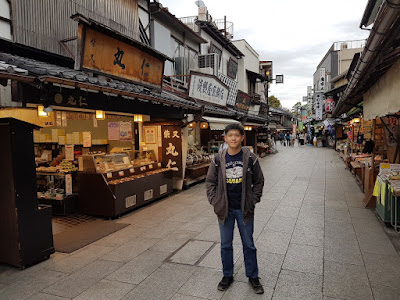My BFF and I took a train from Shinjuku railway station to Nishi-Nippori railway station on Yamanote Line, followed by changing to another train on Chiyoda Line and dropping off at Kanamachi railway station. The journey took slightly longer than 40 minutes. It's possible to take a train from the nearby Keisei Kanamachi railway station to Shibamata railway station, but since the latter is only one stop away, we decided to walk instead to burn a bit more calories before lunch.
 |
"Under my umbrella, ella, ella, eh, eh, eh..." Oops, sorry, I just can't help it!
|
As soon as we reached Shibamata, we tried to look for two famous unagi (Japanese freshwater eel) restaurants: Kawachiya and Yebisuya. As the latter turned out to be closed that afternoon, we went to the former.
 |
| The restaurant has been broiling unagi for more than 250 years. |
 |
'Open' the lacquered box by clicking here!
|
Streching over 200 m, Taishakuten Sando is a shopping street left untouched by the air raids of World War II, offering a glimpse into Tokyo's past before rapid modernisation.
 |
Indeed, some shops along the quaint street have been around since the Edo period.
|
 |
Senbei (lit. Japanese rice rackers) are popular snacks in Shibamata.
|
 |
Be like a Daruma, always bouncing back whenever we fall.
|
At the end of the shopping street is Shibamata Taishakuten, a Buddhist temple founded in 1629.
 |
| Known as Nitenmon, the carved wooden gate was erected in 1896. |
It was my very first time seeing such a unique fortune-telling vending machine. I didn't try it out, but do take a look at the short video clip of the moving shishimai, a Japanese lion dance icon.
Worth mentioning is Jogyo Bosatsu that's said to be able to heal your localised bodily pain when you wash that same part of the Buddha statue.
 |
| Here's a photo of my BFF washing the lower back of the statue. |
I'm not too sure of the opening hours of the main hall, but it was closed when we were there slightly before 3.00pm.
 |
In front of the main hall stands a large pine tree named Zuiryu No Matsu that resembles a dragon.
|
 |
If you have time to spare, check out the paid area featuring intricate carvings that depict scenes
from Buddhist scriptures and local folklore. The entrance fee is ¥400 (~S$5.15). |
 |
The office looks surprisingly modern.
|
 |
What comes to mind when you see the gold stuff carried by the snakes?
|
From the temple, it's a 10-minute walk to Edo River.
 |
I love kakigori (Japanese shaved ice) topped with green tea sauce and condensed milk.
|
Enjoy the panorama shot below.
For a moment, somehow I was reminded of the river area in my all-time favourite anime: Doraemon.
 |
In the midst of all the craziness right now, I'd kill to have a zen moment there.
|
 |
That stray dog followed us as we made our way to the river.
|
Fancy crossing the Edo River to Matsudo city in Chiba Prefecture on a traditional boat? Known as Yagiri No Watashi, it's the only place left in Tokyo to have such an experience.
 |
Yagiri No Watashi is also a song title by Takashi Hosokawa, which was a number one hit in 1983.
Engraved there are the lyrics that speak of a couple eloping by crossing a river on a boat.
|
 |
| A one-way trip costs ¥200 (~S$2.55) per adult or half of that per child. |
After enjoying the scenery and the nice breeze, we walked back to Taishakuten Sando, looking for snacks to munch on.
 |
Get some sweets from Marujin. I'm sure you won't be disappointed.
|
Leaving Shibamata was hard, especially when it was also my last day in Tokyo before flying back home.
 |
Seeing an old-school sundry shop always brings me down the memory lane.
|
In front of Shibamata railway station is a statue of Tora-san, a kind-hearted vagabond who's the main character of a popular TV series released between 1969 and 1995 called Otoko Wa Tsurai Yo (lit. It's Tough Being a Man).
We didn't take a train from there, but instead continued walking to Keisei Takasago railway station.
 |
It was so quiet that we could clearly hear our footsteps.
|
 |
Baskin-Robbins X Minions!
|
Has any non-Japanese here watched Otoko Wa Tsurai Yo before?





































































Comments
Post a Comment